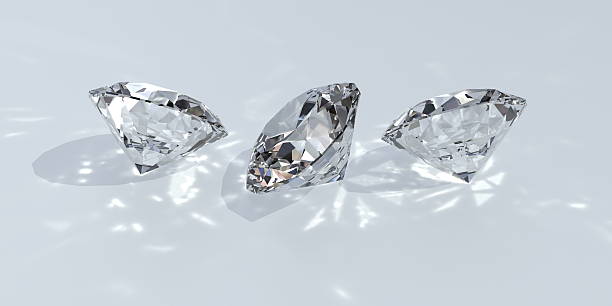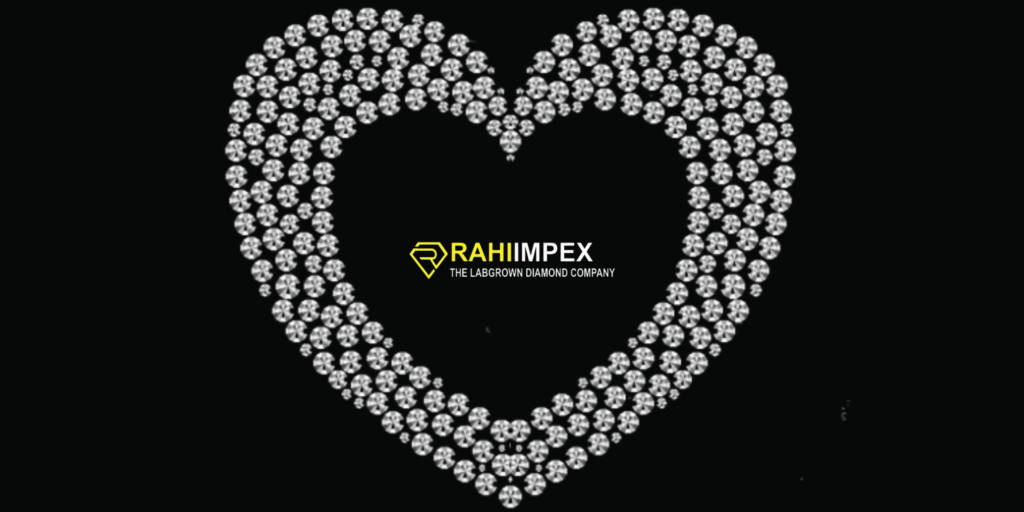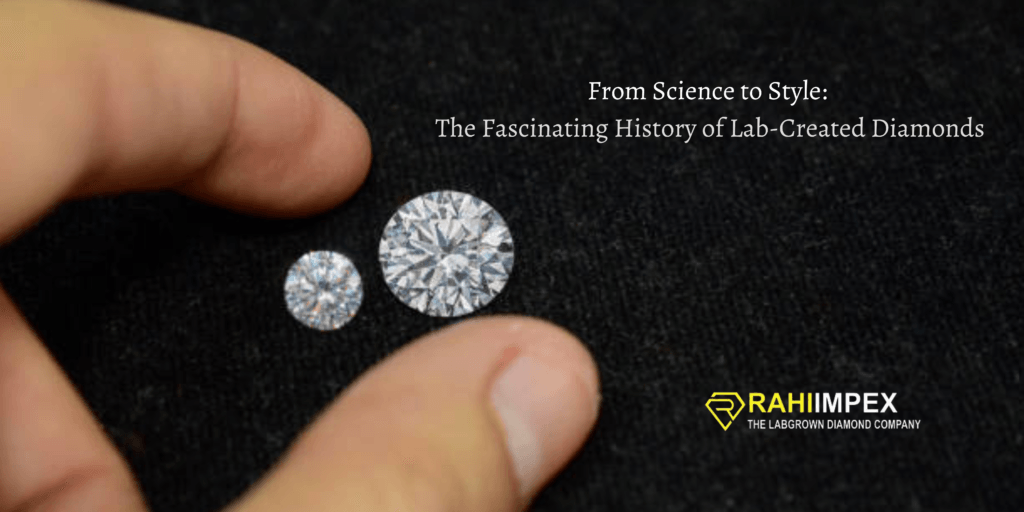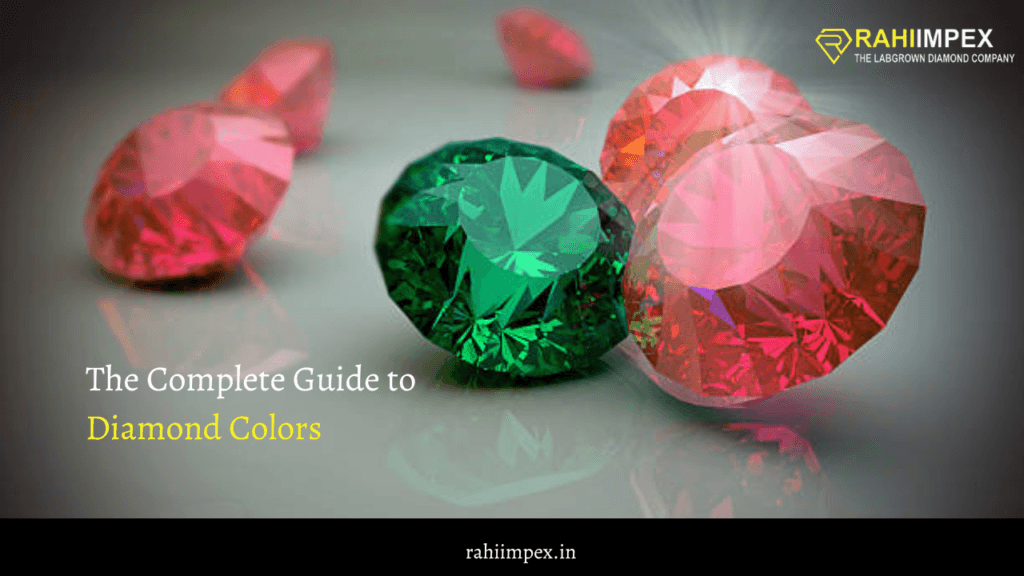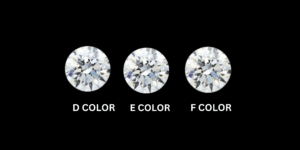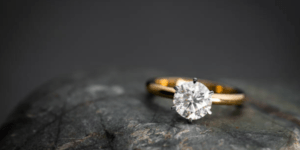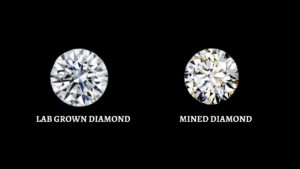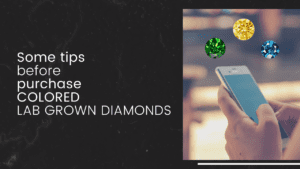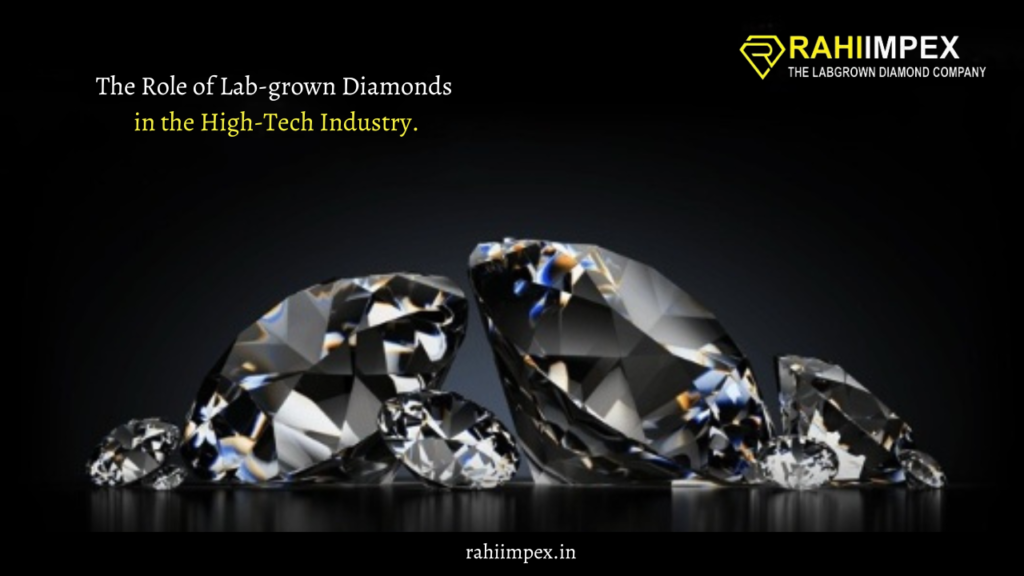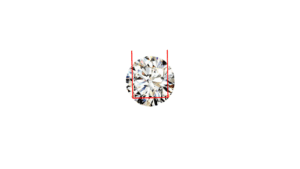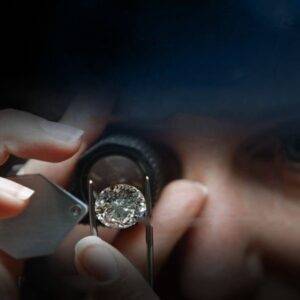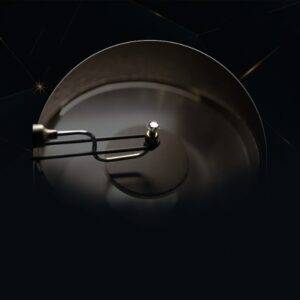Introduction
Diamonds are a symbol of love and luxury, but the process of mining natural diamonds can be both environmentally and ethically questionable. Enter lab-grown diamonds, also known as synthetic diamonds. These diamonds are created in a laboratory using advanced technology and offer a more sustainable and responsible option for consumers. But lab-grown diamonds haven’t always been so widely accepted. In this blog post, we’ll explore the fascinating history of lab-created diamonds and how they’ve evolved from scientific experiments to mainstream jewelry.
In the past, lab-grown diamonds were seen as less valuable or “fake” compared to natural diamonds. However, with advancements in technology, lab-grown diamonds are virtually identical to natural diamonds, making them a more sustainable and ethical option for consumers.
The origins of lab-grown diamonds can be traced back to the 1950s when scientists first began experimenting with ways to create diamonds in a laboratory setting. These early attempts yielded small, low-quality diamonds that were primarily used for industrial purposes. It wasn’t until the 1970s and 1980s that lab-grown diamonds started to resemble natural diamonds and be used in jewelry.
Despite the improvements in quality, lab-grown diamonds were still met with skepticism and resistance from the traditional diamond industry. However, as consumers become more conscious of the environmental and ethical issues surrounding natural diamond mining, lab-grown diamonds have seen a rise in popularity.
In recent years, lab-grown diamond technology has continued to advance, making the diamonds even more indistinguishable from natural diamonds and more affordable for consumers. With these advancements, lab-grown diamond manufacturers have the potential to become the norm in the jewelry industry.
In this blog post, we’ll delve into the history, impact, and future of lab-created diamonds, so you can understand why they’re becoming a more popular and responsible choice for fine jewelry.
The Origins of Lab-Grown Diamonds: From Scientific Experiment to Mainstream Jewelry
The journey of lab-grown diamonds began in the 1950s when scientists first began experimenting with ways to create diamonds in a laboratory setting. These early attempts yielded small, low-quality diamonds that were primarily used for industrial purposes such as drilling and cutting. However, these early successes laid the foundation for the development of lab-grown diamond technology.
It wasn’t until the 1970s and 1980s that lab-grown diamonds started to resemble natural diamonds and be used in jewelry. Scientists and researchers continued to improve upon the process of growing diamonds in a lab, making the diamonds more similar in appearance and quality to natural diamonds.
Despite the improvements in quality, lab-grown diamonds were still met with skepticism and resistance from the traditional diamond industry. The industry viewed lab-grown diamonds as a threat to the exclusivity and value of natural diamonds.
However, as consumers become more conscious of the environmental and ethical issues surrounding natural diamond mining, lab-grown diamonds have seen a rise in popularity. The diamond industry has also begun to embrace lab-grown diamonds as a way to offer more sustainable and responsible options to consumers.
In conclusion, The origins of lab-grown diamonds can be traced back to the 1950s, when scientists first began experimenting with ways to create diamonds in a laboratory setting. These early attempts laid the foundation for the development of lab-grown diamond technology, which has continued to evolve and improve over the decades, making lab-grown diamonds more similar in appearance and quality to natural diamonds and more acceptable to the general public.
The Rise of Lab-Created Diamonds: Understanding their Impact
As lab-grown diamonds have become more widely accepted and popular in the jewelry industry, their impact on both the diamond industry and the world at large has become increasingly apparent.
One of the key benefits of lab-grown diamonds is their sustainability. Unlike natural diamonds, which are mined from the earth, lab-grown diamonds are created in a laboratory using advanced technology. This eliminates the need for diamond mining, which can have significant negative impacts on the environment. The process of mining natural diamonds can cause soil erosion, habitat destruction, and pollution of water sources. Lab-grown diamonds offer a more sustainable option for consumers who are looking to purchase diamonds without contributing to these negative impacts.
In addition to their environmental benefits, lab-grown diamonds also have ethical advantages. The diamond mining industry has a history of human rights abuses, including forced labor and child labor. Lab-grown diamonds, on the other hand, are created in controlled and monitored laboratory settings, eliminating the need for such practices.
The rise of lab-grown diamonds has also had an impact on the traditional diamond mining industry. As lab-grown diamonds have become more widely accepted, they have begun to compete with natural diamonds in the marketplace, potentially affecting the demand and value of natural diamonds. However, some diamond companies have embraced lab-grown diamonds, offering them as a sustainable and ethical alternative to natural diamonds.
In conclusion, Lab-grown diamonds offer a sustainable and ethical alternative to natural diamonds. The rise of lab-grown diamonds in the lab-grown diamond jewelry industry has brought attention to the negative impacts of diamond mining on the environment and human rights. It also has had an impact on the traditional diamond mining industry by competing with natural diamonds in the marketplace, but some diamond companies have embraced them as a sustainable and ethical alternative.
The Future of Lab-Created Diamonds: Innovations and Advancements
As technology continues to advance, the future of lab-grown diamonds looks bright. Scientists and researchers are constantly finding new ways to improve upon the process of growing diamonds in a lab, making the diamonds even more indistinguishable from natural diamonds and more affordable for consumers.
One of the major advancements in lab-grown diamond technology is the use of chemical vapor deposition (CVD) and high-pressure high-temperature (HPHT) methods. These methods allow for larger and higher-quality lab-grown diamonds to be produced at a faster rate, making them more accessible to consumers.
New innovations are also allowing for more accurate and efficient grading of lab-grown diamonds. This will make it easier for consumers to determine the quality of a lab-grown diamond and will also increase the transparency of the lab-grown diamond industry.
In addition, with the increasing demand for sustainable and ethically-sourced products, lab-grown diamonds have the potential to become the norm in the jewelry industry, as more and more consumers opt for lab-grown diamonds over natural diamonds.
In conclusion, The future of lab-grown diamonds is bright as technology continues to advance, making the diamonds even more indistinguishable from natural diamonds and more affordable for consumers. Advancements in lab-grown diamond technology include the use of chemical vapor deposition (CVD) and high-pressure high-temperature (HPHT) methods and innovations in the grading process, making them more accurate and efficient. With the increasing demand for sustainable and ethically-sourced products, lab-grown diamonds have the potential to become the norm in the jewelry industry.
The Consumer Perspective: Adoption and Acceptance of Lab-Created Diamonds
As lab-grown diamonds have become more widely available and advancements in technology have made them virtually indistinguishable from natural diamonds, consumer acceptance and adoption of lab-grown diamonds have been on the rise.
Many consumers are drawn to lab-grown diamonds for their sustainability and ethical advantages. They see lab-grown diamonds as a way to purchase a diamond without contributing to the negative impacts of diamond mining on the environment and human rights.
In addition, as lab-grown diamonds have become more affordable, they have become more accessible to a wider range of consumers. This has led to an increase in demand for lab-grown diamonds, particularly among younger generations who are more environmentally and socially conscious.
However, there still remains a perception among some consumers that lab-grown diamonds are less valuable or “fake” compared to natural diamonds. This perception is slowly changing as more and more consumers become educated about lab-grown diamonds and their benefits.
In conclusion, consumer acceptance and adoption of lab-grown diamonds have been on the rise as they become more widely available, affordable, and indistinguishable from natural diamonds. Many consumers are drawn to lab-grown diamonds for their sustainability and ethical advantages and particularly younger generations who are more environmentally and socially conscious. However, there’s still a perception among some consumers that lab-grown diamonds are less valuable or “fake” compared to natural diamonds but with more education, this perception is expected to change
The Role of Jewelers and the Diamond Industry in Promoting Lab-Created Diamonds
The diamond industry and jewelers have a significant role in promoting and selling lab-created diamonds. They play an important role in educating consumers about the benefits of lab-created diamonds and helping to dispel any misconceptions about their value and quality.
Many jewelers have embraced lab-created diamonds and now offer them as a sustainable and ethical alternative to natural diamonds. This allows consumers to make informed choices about the diamonds they purchase and to support the diamond industry in a more responsible way.
In addition, the diamond industry has begun to develop and implement guidelines and standards for lab-created diamonds, which will help to increase transparency and consumer confidence in lab-created diamonds. This will also help to ensure that lab-created diamonds are accurately graded and labeled, making it easier for consumers to determine the quality of a lab-created diamond.
As consumer demand for lab-created diamonds continues to rise, it is expected that more jewelers and the diamond industry will adopt lab-created diamonds and promote them as a sustainable and ethical option for consumers.
In conclusion, The diamond industry and jewelers have a significant role in promoting and selling lab-created diamonds. They play an important role in educating consumers about the benefits of lab-created diamonds and help dispel misconceptions about their value and quality. Many jewelers now offer lab-created diamonds as a sustainable and ethical alternative to natural diamonds, and the industry is developing guidelines and standards for lab-created diamonds to ensure transparency and consumer confidence. As consumer demand for lab-created diamonds continues to rise, it is expected that more jewelers and the diamond industry will adopt lab-created diamonds and promote them as a sustainable and ethical option for consumers.
The Role of Certification and Labeling in Promoting Lab-Created Diamonds
Certification and labeling of lab-created diamonds play a crucial role in promoting consumer confidence and trust in lab-created diamonds. It helps to ensure that lab-created diamonds are accurately graded and labeled, making it easier for consumers to determine the quality of a lab-created diamond.
Many organizations, such as the International Gemological Institute (IGI) and the Gemological Institute of America (GIA), have developed certification and grading standards for lab-created diamonds. These standards help to ensure that lab-created diamonds are accurately graded and labeled, which helps to increase consumer confidence in lab-created diamonds.
In addition, labeling lab-created diamonds as “lab-grown” or “synthetic” helps to increase transparency and consumer education about the origin of the diamonds. It also allows consumers to make informed choices about the diamonds they purchase.
The role of certification and labeling in promoting lab-created diamonds is crucial as it ensures that consumers are getting what they paid for and that they have the information they need to make an informed decision.
In conclusion, the Certification and labeling of lab-created diamonds play a crucial role in promoting consumer confidence and trust in lab-created diamonds. Organizations like the IGI and GIA have developed certification and grading standards for lab-created diamonds, which help ensure that lab-created diamonds are accurately graded and labeled. Labeling of lab-created diamonds as “lab-grown” or “synthetic” also helps increase transparency and consumer education about the origin of the diamonds and allows consumers to make informed choices about the diamonds they purchase.
The Role of Government and Regulations in Promoting Lab-Created Diamonds
Government regulations play an important role in ensuring that lab-created diamonds are accurately labeled and marketed to consumers. This helps to ensure that consumers are able to make informed choices about the diamonds they purchase and that lab-created diamonds are not falsely marketed as natural diamonds.
In recent years, many governments around the world have implemented regulations to ensure that lab-created diamonds are accurately labeled and marketed to consumers. For example, the Federal Trade Commission (FTC) in the United States has guidelines in place for the labeling and marketing of lab-created diamonds. These guidelines require that lab-created diamonds be labeled as such and that they not be falsely marketed as natural diamonds.
Regulations like these help to increase consumer confidence in lab-created diamonds and ensure that they are not falsely marketed as natural diamonds.
In addition, some governments have also implemented policies to support the development and growth of the lab-created diamond industry, such as providing funding for research and development and tax incentives for companies producing lab-created diamonds.
In conclusion, Government regulations play an important role in ensuring that lab-created diamonds are accurately labeled and marketed to consumers. This helps to ensure that consumers are able to make informed choices about the diamonds they purchase and that lab-created diamonds are not falsely marketed as natural diamonds. Governments around the world have implemented regulations to ensure that lab-created diamonds are accurately labeled and marketed to consumers, this increases consumer confidence in lab-created diamonds. Some governments also have policies to support the development and growth of the lab-created diamond industry, such as providing funding for research and development and tax incentives for companies producing lab-created diamonds.
Conclusion and Final thoughts
In conclusion, lab-created diamonds have come a long way since their invention over a century ago. Advances in technology have made it possible to produce diamonds that are virtually identical to natural diamonds, at a fraction of the cost. This has made diamonds more accessible to a wider range of consumers and has also led to an increase in demand for lab-created diamonds.
Final thoughts, lab-created diamonds are not only an affordable alternative to natural diamonds, but they also have a lower environmental impact and do not contribute to human rights abuses. As technology continues to improve, it’s likely that lab-created diamonds will become an even more viable option for consumers looking for a high-quality diamond at an affordable price.
It’s worth noting that lab-created diamonds have the same physical and chemical properties as natural diamonds, they are not fake diamonds or imitations. They are real diamonds, but they are grown in a lab instead of mined from the earth.

